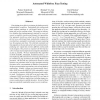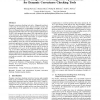64 search results - page 12 / 13 » Certifying Program Execution with Secure Processors |
OOPSLA
2007
Springer
14 years 1 months ago
2007
Springer
Omniscient debuggers make it possible to navigate backwards in time within a program execution trace, drastically improving the task of debugging complex applications. Still, they...
ICCD
2006
IEEE
14 years 4 months ago
2006
IEEE
—Current micro-architecture blindly uses the address in the program counter to fetch and execute instructions without validating its legitimacy. Whenever this blind-folded instru...
NDSS
2008
IEEE
14 years 1 months ago
2008
IEEE
Fuzz testing is an effective technique for finding security vulnerabilities in software. Traditionally, fuzz testing tools apply random mutations to well-formed inputs of a progr...
TDSC
2010
13 years 2 months ago
2010
We describe Instruction-Set Randomization (ISR), a general approach for safeguarding systems against any type of code-injection attack. We apply Kerckhoffs' principle to creat...
PLDI
2010
ACM
14 years 16 days ago
2010
ACM
Dynamic correctness checking tools (a.k.a. lifeguards) can detect a wide array of correctness issues, such as memory, security, and concurrency misbehavior, in unmodified executa...


